Introduction
On 1 October 2022, the US government announced a Five-Year Plan to study the controversial and seemingly sci-fi notion of deflecting the Sun’s rays before they hit Earth in order to temporarily reduce the effects of global warming. Several kinds of sunlight-reflection techniques are being considered for research including stratospheric aerosol injection, marine cloud brightening, and cirrus cloud thinning. Collectively, these techniques are referred to as solar geo-engineering or Solar Radiation Management (SRM). Solar geo-engineering in turn is a sub-set of geo-engineering. The US government’s decision to bolster research into solar geo-engineering is a clear indication of geo-engineering’s growing prominence in debates on climate policy. It is also a reflection of the world’s failure to cut CO2 emissions despite decades of talks. This article explores the current status of geo-engineering worldwide. It argued that geo-engineering can complement ongoing climate mitigation or emissions reduction efforts. Some geo-engineering proposals, such as those pertaining to sunlight-reflection, should be approached cautiously. They should not be implemented until there is good evidence concerning their safety, efficacy and feasibility, and until robust regulatory frameworks are put in place.
What is Geo-engineering?
Geo-engineering or climate engineering is the deliberate large-scale intervention in the Earth's natural systems to counteract climate change. More specifically, it refers to “a set of emerging technologies that could manipulate the environment and partially offset some of the impacts of climate change”.[1] Geo-engineering is not a new idea. Weather modification through cloud seeding is now practiced widely in various parts of the world following the discovery in the 1940s that silver iodide, apale-yellow and odorless powder that is used in photography and medicine, can form ice crystals in some water vapour. Two techniques, hygroscopic cloud seeding and glaciogenic cloud seeding, are employed. Hygroscopic cloud seeding involve dispersing large salt particles to the cloud base to speed up droplet coalescence in liquid clouds, leading to production of large droplets that start to precipitate. Glaciogenic cloud seeding on the other hand involve dispersing silver iodide particles or dry ice (solid carbon dioxide) into the cloud to trigger ice production in supercooled clouds which then precipitate.
Geo-engineering proposals to modify the climate specifically to counteract the greenhouse effect dated from at least the 1960s and preliminary studies were conducted throughout the 1970s and 1990s. The term “geo-engineering” was used for the first time in the early 1970s by Cesare Marchetti, an Italian physicist, to describe the specific technique of injecting CO2 into the deep ocean to counteract climate change. [2] By the 1990s, the number of geoengineering techniques under discussionhave expanded and they include reforestation; increasing ocean absorption of CO2; screening out some sunlight using space mirrors, space dust, stratospheric dust and multiple balloon screens; changing cloud abundance; and atmospheric chlorofluorocarbon removal.[3] However, much of these proposed geoengineering techniques are not being considered seriously. The emphasis of climate policy throughout the 1990s and beyond was on mitigation. As such, discussion even of adaptation, let alone geo-engineering, was seen as a potentially dangerous distraction from the task of emissions reduction. But that has begun to shift.
The inadequacy of climate mitigation efforts, even after decades of intense and at times difficult negotiations, has led to growing interests in geoengineering. Because of the slow pace of emissions reduction efforts, the internationally agreed temperature target of 1.5°C is now perilously close to being breached. Scientists deemed 1.5°C to be a “safe limit” beyond which the impact of climate change would intensify. Average global temperature has already exceeded 1.1°C. The United Nations reported in 2022 that even if current pledges for action by 2030 are delivered in full, global temperature would still rise by 2.5°C. And if the long-term pledges by countries to hit net zero emissions by 2050 were delivered, global temperature would rise by 1.8°C. Thus, no matter what the world does, the 1.5°C temperature threshold will be exceeded in the coming years. That prospect has reinvigorated global interests in geo-engineering, among developed countries of Europe and North America in particular. Two types of geo-engineering solutions have been discussed and debated. They are carbon geo-engineering/Carbon Direct Removal (CDR) and solar geo-engineering/Solar Radiation Management (SRM). Carbon geo-engineering attempts to remove some of the CO2 from the atmosphere and sequester it in the ground or in the ocean. Solar geo-engineering on the other hand attempt to reflect some of the sun’s energy back into space to reduce the warming effect of increasing levels of greenhouse gases in the atmosphere.
Carbon geo-engineering is viewed more favourably than solar geo-engineering. This is because some of the proposed techniques such as planting trees, improving the management of existing forests, restoration of peatlands and coastal wetlands etc. are in fact Nature-based Solutions (NbS). NbS involve working with nature and boosting natural ecosystems and biodiversity to address climate change and they have multiple co-benefits including sequestering carbon, regulating global temperatures and freshwater flows, recharging groundwater, anchoring fertile soil, acting as flood barriers, etc. Planting trees in particular have become very popular and many countries have embraced it. A 2019 study published in the journal Science estimated that 900 million hectares of available land around the world could hold more than a trillion more trees.[4] Not surprisingly, the World Economic Forum (WEF) has initiated a global movement to plant one trillion trees across the world by 2030. Ocean fertilization is another carbon geo-engineering technique that has already been tested widely. It involve adding nutrients to the upper (sunlit) layers of the ocean to stimulate phytoplankton activity (photosynthesis) in an attempt to draw down atmospheric CO2 levels. Between 1990 and 2016, researchers worldwide have conducted 13 major iron-fertilization experiments in the open ocean with varying degrees of success.[5] Carbon Capture and Storage (CCS), another CO2 removal technique, have also been deployed increasingly. CCS involve removing CO2 produced by power generation or industrial activity. The CO2 that are removed are transported by ships or pipelines and they are stored deep underground.
Although solar geo-engineering was viewed less favourably than carbon geo-engineering, there is growing interest in researching it. One of most discussed and debated technique of recent years was stratospheric aerosols injection. It involve spraying aerosols – such as sun-reflecting sulfur dioxide particles – into the stratosphere, 16-25 kilometers above the Earth’s surface, to reflect sunlight back into space. This can be done with balloons or specialized airplanes able to fly at high altitude. Stratospheric aerosols injection aimed to mimic the cooling effect of large volcanic eruptions. When Mount Pinatubo erupted in the Philippines in 1991, the sulfur dioxide it expelled high into the atmosphere had the effect of temporarily cooling the planet by 0.5°C for a year or more.[6] Experts viewed this technique to be relatively straightforward and easy to deploy at least from a technological point of view. Also, the financial costs of deploying it is considered to be relatively modest. David Keith, professor of applied physics and of public policy at Harvard University, and one of the world’s leading experts on solar geo-engineering, estimated that around two million tons of sulfur a year, injected via a fleet of about 100 high-flying aircraft, would cool the planet by around 1°C.[7] Private companies are in on the act too. Make Sunsets, launched in 2020, aim to make “shiny clouds” by injecting sulfur dioxide via balloons into the stratosphere, more than 20 kilometers above the Earth’s surface. The company claimed that through this technique, it could return the world to its pre-industrial temperature for just USD 50 billion per year (USD 12 billion of sulphur dioxide plus deployment costs).
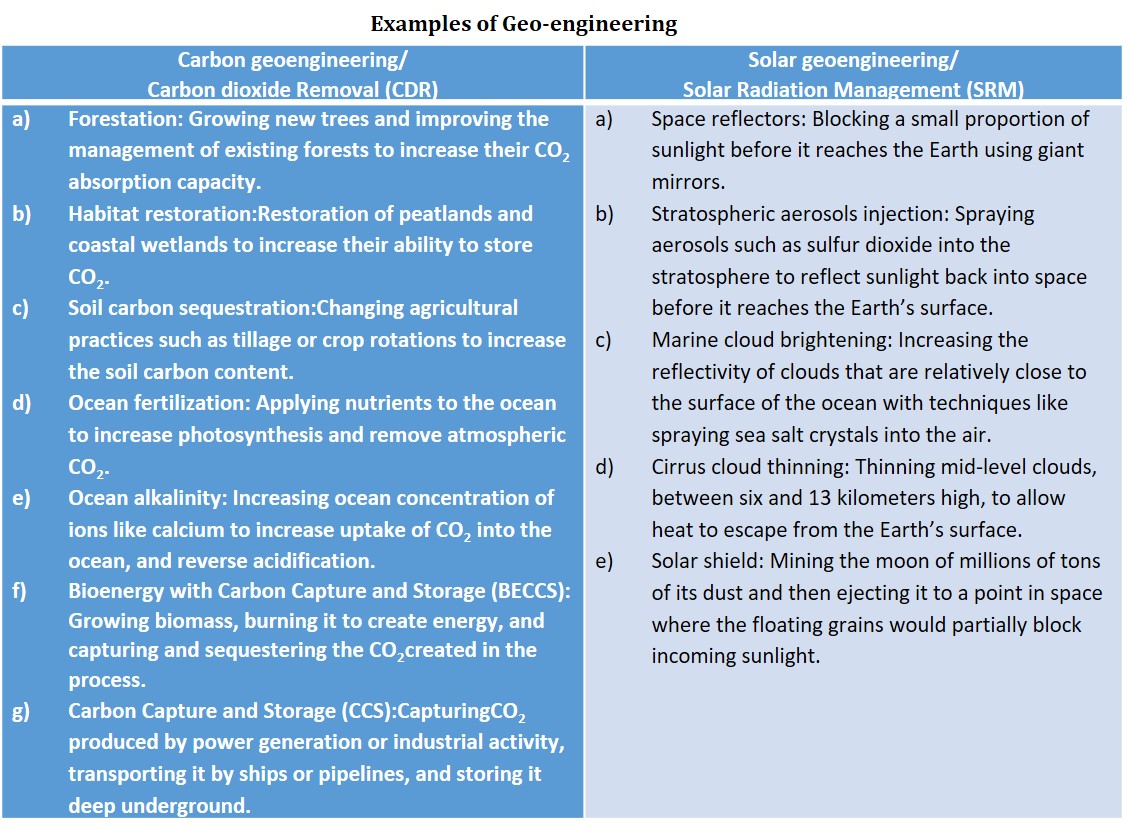
Current Status of Geo-engineering
Geo-engineering remained highly contentious and scientists are divided over it. An open letter signed by more than 370 academics from more than 50 countries call for “immediate political action…to prevent the normalization of solar geo-engineering as a climate policy option” and demanded an “International Non-Use Agreement on Solar Geo-engineering”.[8] These group of scientists deemed growing calls for geo-engineering research a “cause for alarm”, due to an unknown set of ramifications that will have varying consequences in different parts of the world. Research have shown that stratospheric aerosol injection could deplete the ozone layer.[9] The sulfur injected into the stratosphere could also eventually come down as acid rain and that could affect soil, water reservoirs, and local ecosystems adversely. Also, massive amount of sulfur in the atmosphere can cause respiratory illness. Then there is the potential occurrence of “termination shock”. The addition of aerosols would have to be continuous to maintain the cooling. Any disruption, either intentional or otherwise, would cause a sort of “termination shock”, where bottled up warming would be unleashed in a disastrously rapid jolt. That would lead to crop failures on a massive scale. Opponents of geo-engineering also worry that ocean fertilisation might feed too much algal growth, leading to toxic blooms. That would have adverse consequences for marine life. Then there are the geopolitical risks. Unilateral action to alter the climate could spark conflict if one part of the world benefits, while another suffers knock-on droughts or floods. There is also the high likelihood of rogue states deploying geo-engineering as weapons. There are also concerns that geo-engineering could threaten commitments to mitigation and disincentivize governments, businesses, and societies to do their utmost to achieve carbonization or carbon neutrality as soon as possible.
Proponents of geo-engineering in turn argued that the impacts of global warming could be so great that every option to limit these must be explored. A 2019 study published in the peer-reviewed journal Nature Climate Change contradicted fears that using solar geo-engineering could dangerously alter rainfall and storm patterns in some parts of the world. The study finds that cooling the Earth enough through solar geo-engineering to eliminate roughly half of warming, rather than all of it, generally would not make tropical cyclones more intense or worsen water availability, extreme temperatures or extreme rain. Only a small fraction of places, 0.4 per cent, might see climate change impacts worsened, the study says.[10] Even the Intergovernmental Panel on Climate Change (IPCC) argued in a special report titled Global Warming of 1.5°C that was published in 2018 that stratospheric aerosol injection may be necessary but would come with major uncertainties.[11] It suggested that the technique could be adopted as a temporary “remedial measure” if the world heads towards dangerous levels of warming.
Debates over geo-engineering will continue. It will even intensify in the coming years. But one thing is certain -there is no walking away from it anymore. Referring to solar geo-engineering, Edward A. Parson, a professorof environmental law at the University of California, Los Angeles (UCLA), opined that “…it’s more than 90 percent likely that within the next 20 years, some major nation wants to do this”.[12] Another expert puts the odds even higher. Chris Sacca, founder of climate tech investment fund Lowercarbon Capita, argued that “The odds are 100 per cent that some country pursues sunlight reflection, particularly in the wake of seeing millions of their citizens die from extreme weather”. He continued that “The world will not stand idly by and leaders will feel compelled to take action. Our only hope is that by doing the research now, and in public, the world can collaboratively understand the upsides and best methods for any future project”.
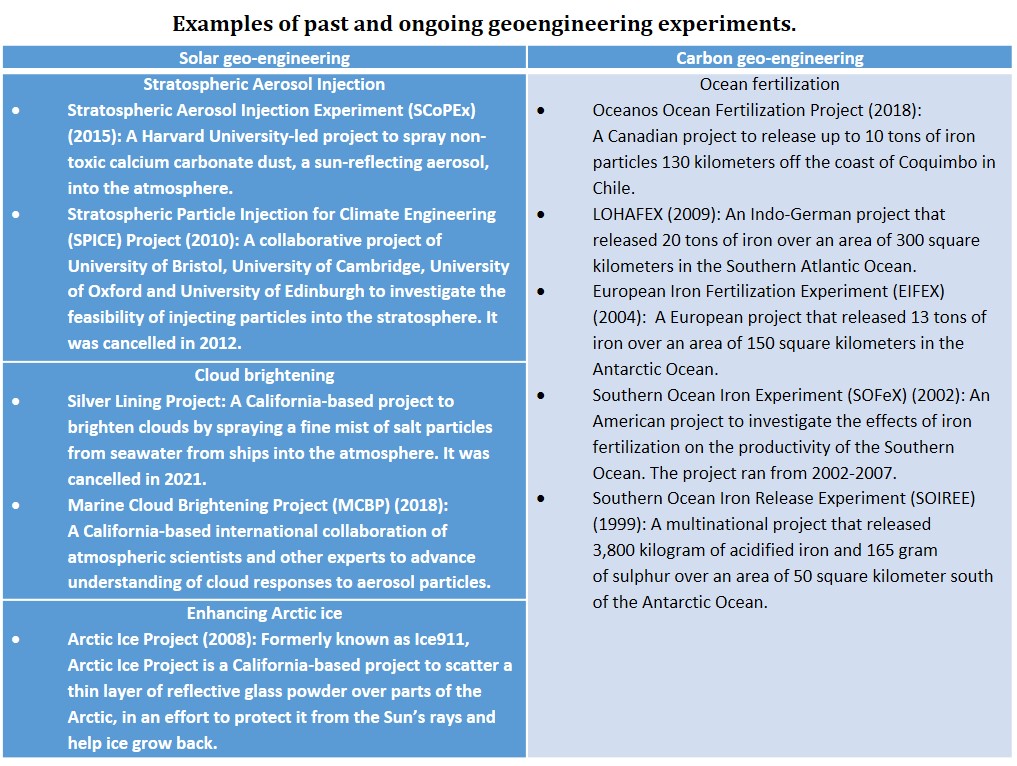
Current Status of Geo-engineering in India
Once relegated to the fringes of science, interest in geo engineering has surged especially in Europe and North America. A number of geo-engineering techniques have now been tested, but as yet none deployed at a scale that would affect the climate. As the impact of climate change intensifies, and if mitigation does not massively increase, there is a high probability of more geoengineering techniques being deployed in the coming years. In India, there is currently a lack of coordinated national effort for geo-engineering research and the Indian government has no official policy on the issue. However, initial steps to further the understanding of geo-engineering are now being taken. For example, the Department of Science and Technology (DST), a department under the Ministry of Science and Technology and the main funding agency for scientific research in India, included geo-engineering in its lists of Major R&D Project (MRDP). MRDPs are carefully chosen scientific research projects and research responsibilities are entrusted to selected universities and institutions. The responsibility for spearheading geo-engineering research in India has been given to the Centre for Amospheric and Oceanic Sciences (CAOS) at the Indian Institute of Science (IISc) in Bengaluru, Karnataka. CAOS has since organised a national roundtable on geo-engineering titled “Geo-engineering and India: Science and Policy” at the Indian Institute of Technology (IIT) in Delhi on 23 June 2017. Attended by about 35 participants from 14 institutions, the roundtable recommended that DST should encourage various research groups to undertake geo-engineering research in the country through a network programme.[13] It also recommended that DST should foster research on the unintended consequences of geo-engineering for India. These are critical recommendations because scientific understanding of many aspects of geo-engineering, solar geo-engineering in particular, remains limited, including how they could affect weather extremes, agriculture, natural ecosystems, or human health.
Take stratospheric aerosol injection, the most talked about solar geo-engineering techniques, as an example. This technique involve spraying large quantities of tiny reflective particles into the stratosphere in order to cool the planet by reflecting sunlight back into space. Proposals ranged from spraying sulfur dioxides or finely powdered salt or calcium carbonate from aircrafts, artillery guns or even hoses into the sky. However, there are concerns that spraying reflective particles could impact the Indian summer monsoon adversely. Studies have shown that global monsoon precipitation responds to large volcanic eruptions. Whereas northern hemisphere monsoon precipitation is weakened by northern hemisphere and equatorial volcanic eruptions, it is enhanced by southern hemisphere eruptions. Stratospheric aerosol injection attempts to mimic the cooling effect of volcanic eruptions. As such, it could also have the impact on the Indian summer monsoon as did large volcanic eruptions. Going forward, it is imperative that India pursues scientific research on geo-engineering vigorously. Such research should aim to enhance Indian policymakers’ understanding of climate response options. It should also lead to better understanding of geo-engineering’s technical feasibility, possible impacts on society and the environment, public perceptions, and potential social responses.
Endnotes :
[1]Harvard University. 2023. “Geoengineering”. Harvard’s Solar Geoengineering Research Program. Harvard University Center for the Environment.
https://geoengineering.environment.harvard.edu/geoengineering
[2]Marchetti, Cesare. 1976. “On geoengineering and the CO2 problem”. Climatic Change 1. Pp. 59-68. March. https://pure.iiasa.ac.at/id/eprint/667/1/RM-76-017.pdf
[3]Panel on Policy Implications of Greenhouse Warming. 1992. “Policy Implications of Greenhouse Gas Warming: Mitigation, Adaptation, and the Science Base”. Washington, DC: National Academy Press. https://www-legacy.dge.carnegiescience.edu/labs/caldeiralab/Caldeira%20downloads/Geoengineering_NAS1992.pdf
[4]Bastin, Jean-Francois et al. 2019. “The global tree restoration potential”. Science. Volume 365. Issue. 6448. Pp. 76-79. https://www.regenwald-statt-palmoel.de/images/pdf/The-global-tree-restoration-potential.pdf
[5]Joo-Eun Yoon et al. 2016. “Ocean Iron Fertilization Experiments: Past–Present–Future with Introduction to Korean Iron Fertilization Experiment in the Southern Ocean (KIFES) Project”. Biogeosciences Discussion. November 15. https://d-nb.info/1143063074/34
[6] “The Cataclysmic 1991 Eruption of Mount Pinatubo, Philippines”. U.S. Geological Survey Fact Sheet 113-97. U.S. Geological Survey (USGS). Last modified on February 28, 2005.
https://pubs.usgs.gov/fs/1997/fs113-97/
[7]Milman, Oliver. “Can geoengineering fix the climate? Hundreds of scientists say not so fast.” The Guardian. December 25, 2022. https://www.theguardian.com/environment/2022/dec/25/can-controversial-geoengineering-fix-climate-crisis
[8] “We Call for an International Non-Use Agreement on Solar Geoengineering”. Open Letter. Solar Geoengineering Non-Use Agreement. 2021.
https://www.solargeoeng.org/non-use-agreement/open-letter/
[9]Nowack, Peer Johannes, Nathan Luke Abraham, Peter Braesicke, and John Adrian Pyle. 2016. “Stratospheric ozone changes under solar geoengineering: implications for UV exposure and air quality”. Atmos. Chem. Phys. 16. Pp. 4191–4203.
https://acp.copernicus.org/articles/16/4191/2016/acp-16-4191-2016.pdf
[10]Irvine, Peter et al. 2019. “Halving warming with idealized solar geoengineering moderates key climate hazards”. Nature Climate Change. Volume 9. April. Pp. 295-299. https://www.nature.com/articles/s41558-019-0398-8.epdf?sharing_token=9B2w04moFqG3vb2yDj8Dx9RgN0jAjWel9jnR3ZoTv0OEvapK86-44yHpunDU3VD1Qn8gsnII9Gq_ul02M36FCVS_W8UIY1Tp0PogdpciGrnii2Z0zvxJUwg775V7SqwYIPvNiyA0jpi2T3hxPVh3PNhVrEuGkHEsNkyKPN90vTxuzN943Nn2eG2tFTdx_7saewx37jOvjI2_03rEdHm6Ga2ZFTkYNMhpuKX22VKBbig68TXAOlI1NTEKoO9cbrXKkUy0ACyZMH5ygeuNNW_eNP3IBE58ygapiOl5GUev2-sj97VWo5wKmrELss6KV9rf&tracking_referrer=www.theguardian.com
[11]Intergovernmental Panel on Climate Change (IPCC). 2018. “Summary for Policymakers”. In: Global Warming of 1.5°C. An IPCC Special Report on the impacts of global warming of 1.5°C above pre-industrial levels and related global greenhouse gas emission pathways, in the context of strengthening the global response to the threat of climate change, sustainable development, and efforts to eradicate poverty [Masson-Delmotte, V., P. Zhai, H.-O. Pörtner, D. Roberts, J. Skea, P.R. Shukla, A. Pirani, W. Moufouma-Okia, C. Péan, R. Pidcock, S. Connors, J.B.R. Matthews, Y. Chen, X. Zhou, M.I. Gomis, E. Lonnoy, T. Maycock, M. Tignor, and T. Waterfield (eds.)]. Cambridge University Press, Cambridge, UK and New York, NY, USA, pp. 3-24. https://www.ipcc.ch/site/assets/uploads/sites/2/2022/06/SPM_version_report_LR.pdf
[12]Clifford, Catherine. White House is pushing ahead research to cool Earth by reflecting back sunlight”. CNBC. October 13, 2022. https://www.cnbc.com/2022/10/13/what-is-solar-geoengineering-sunlight-reflection-risks-and-benefits.html
[13] “Geoengineering and India”. Meeting Report. Current Science. Vol. 13. No. 3. August 10, 2017. https://www.currentscience.ac.in/Volumes/113/03/0376.pdf
(The paper is the author’s individual scholastic articulation. The author certifies that the article/paper is original in content, unpublished and it has not been submitted for publication/web upload elsewhere, and that the facts and figures quoted are duly referenced, as needed, and are believed to be correct). (The paper does not necessarily represent the organisational stance... More >>
Image Source: https://www.forbes.com/sites/startswithabang/2020/01/04/ask-ethan-could-we-just-build-a-space-shade-to-counteract-global-warming/?sh=24f3226743bc

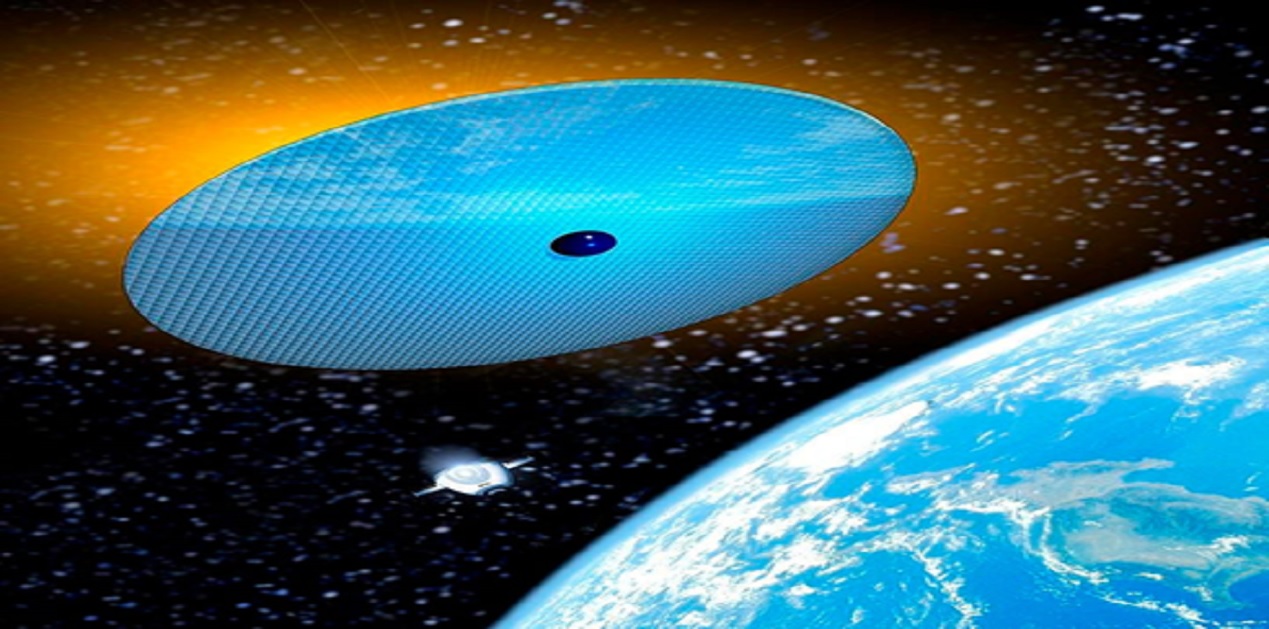







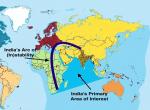
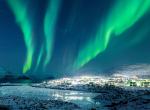
Post new comment